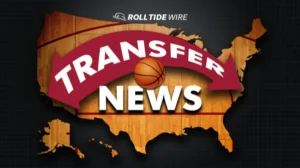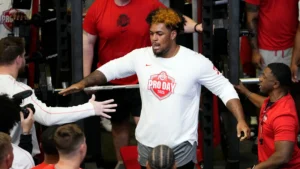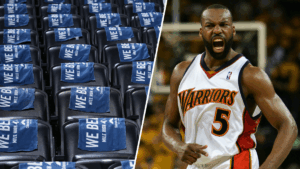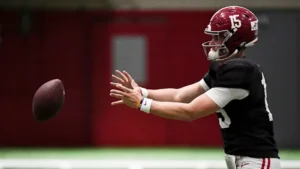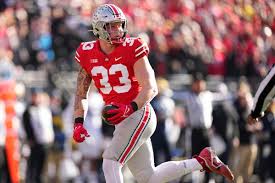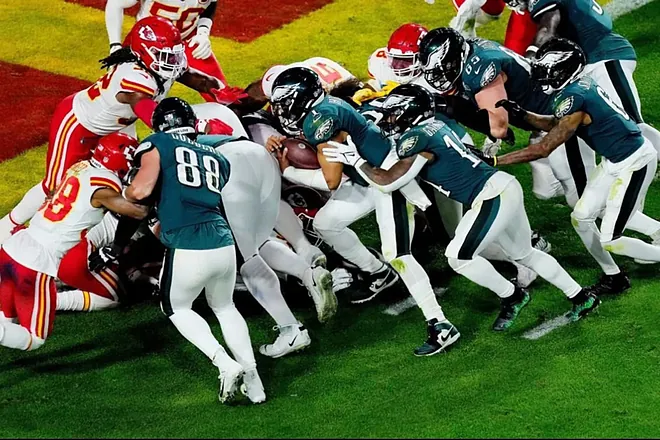
Heated Debate Surrounds the ‘Tush Push’ at NFL Meeting Ahead of Tuesday’s Vote
As the NFL continues to evolve and adapt to changing styles of play, one of the most talked-about topics heading into the 2025 season is the future of the so-called “Tush Push.” This term, referring to a controversial play where a quarterback is pushed by teammates to gain a few extra yards, has sparked heated debates among coaches, players, and league officials. The play was made famous by the Philadelphia Eagles, who utilized it to great effect in recent seasons, particularly during short-yardage situations like fourth-and-1 or goal-line stands. With the league’s annual meeting on the horizon and a vote set for Tuesday, the fate of the Tush Push is hanging in the balance. Will the NFL ban the play, or will it remain part of the playbook for years to come?
The conversation surrounding the Tush Push began in earnest during the 2023 season when the Eagles showcased just how effective it could be. Quarterback Jalen Hurts, known for his powerful build and athleticism, became the poster child for the play. The Eagles’ ability to push Hurts forward with multiple offensive linemen and running backs creating a wall was a game-changer. The tactic allowed them to convert on key short-yardage situations with near-perfect efficiency, sparking frustration among opposing teams who struggled to stop it.
Despite its success, the Tush Push has drawn sharp criticism from various factions within the NFL. Those who oppose the play argue that it presents an unfair advantage, one that undermines the spirit of football. They believe that such a strategy effectively turns the game into a contest of strength rather than skill. Critics also argue that the play opens the door for injuries, particularly to the players in the scrum, who are often subjected to intense physical force as they push and shove for a few extra yards.
One of the most vocal critics of the Tush Push is Washington Commanders head coach Ron Rivera. Rivera, who has long been an advocate for player safety and the preservation of football’s integrity, has expressed his concerns about the potential dangers the play could pose. In a statement released before the NFL’s annual meeting, Rivera said, “This is not football. This is not the way the game is meant to be played. We have to be cautious when it comes to player safety. A play like this could lead to unnecessary injuries, especially to the legs and backs of those involved.”
While Rivera’s concerns about safety are certainly valid, they have been met with pushback from others who believe that the Tush Push is just another part of the game. Supporters of the play argue that it’s a legal and highly effective strategy that has been part of football for decades in various forms. They point to the fact that many teams use similar tactics in short-yardage situations, even if they don’t have the same level of success as the Eagles. Furthermore, supporters argue that it’s an essential part of modern football strategy and that banning it would be an overreaction.
One of the most outspoken defenders of the Tush Push has been Eagles head coach Nick Sirianni. Sirianni, who has overseen the Eagles’ dominant use of the play, insists that it is not only legal but also one of the most efficient ways to gain a few crucial yards. In a press conference before the meeting, Sirianni passionately defended his team’s success with the play. “It’s a part of the game, just like any other play we run,” Sirianni said. “We’re not breaking any rules. We’re using the rules to our advantage. I don’t understand why that’s an issue. We’re just doing our job.”
Sirianni’s comments echo those of many who believe the Tush Push is simply a result of clever coaching and player execution. In the world of professional football, where small advantages can make a huge difference, finding a play that consistently works is a valuable asset. Given the increasing emphasis on analytics in the NFL, many teams are now taking a closer look at short-yardage plays to maximize their chances of success. In that context, the Tush Push becomes a weapon in the strategic arsenal of any team willing to embrace it.
The Tush Push debate has also extended beyond the field, with former players weighing in on the issue. Many ex-players, who are familiar with the brutal nature of the game, have expressed concerns about the physical toll the play could take on players. Former NFL running back Marshawn Lynch, known for his aggressive style of play, made headlines when he weighed in on the controversy. “I get it, it’s effective,” Lynch said in a recent interview. “But it’s also a dangerous play. You’re pushing someone’s body into a pile of bodies, and that’s just asking for trouble. Injuries are going to happen.”
Lynch’s comments were echoed by others who believe that the Tush Push may be a play that is too risky for the long-term health of players. The intense physical contact involved in the play could lead to more than just minor injuries. Some fear that it could result in significant joint and spine issues for players who are constantly involved in the push, especially over the course of a long season.
Despite the concerns raised by critics, there are still many who believe the Tush Push should remain a part of the NFL playbook. Proponents of the play argue that its success is not just about brute strength, but also about the skill and timing involved in executing it. Quarterbacks like Jalen Hurts, who have shown a unique ability to both push forward and protect themselves from potential injury, are part of the reason why the Tush Push has become so successful. Without a quarterback who has the necessary balance of power and awareness, the play simply would not work as effectively.
As the NFL approaches its vote on the matter, it is clear that the decision will not be an easy one. Coaches, players, and league officials will have to balance player safety with the desire for competitive fairness. There is no doubt that the Tush Push has become one of the most effective and controversial plays in the modern NFL. Whether it stays or goes, one thing is certain: this debate will likely continue to shape conversations in NFL locker rooms and boardrooms for years to come.
Ultimately, the NFL’s decision on the Tush Push will have far-reaching implications. If the league votes to ban the play, it would mark a significant shift in the way teams approach short-yardage situations. It could also open the door for more creative and potentially more dangerous plays to emerge. On the other hand, if the vote allows the Tush Push to remain in play, it could further cement the importance of power running and physicality in today’s NFL.
For now, as the vote looms large on Tuesday, the NFL is faced with a difficult decision. Will the Tush Push remain a tool in the strategic arsenal of NFL teams, or will it be consigned to the history books as a brief but controversial chapter in the game’s ever-evolving story? Only time will tell. But one thing is for certain: the Tush Push has sparked one of the most passionate debates in recent NFL history, and the outcome will have a lasting impact on the future of the game.

